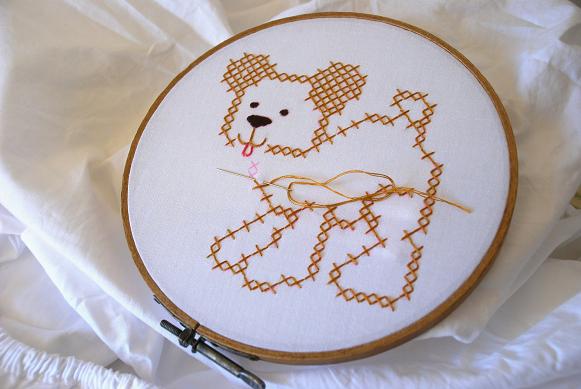I love the way this set of hotpads turned out. I made them to go into the set that includes these dishcloths and these dishtowels. Miss Abigail is also working on this set and has completed this dishtowel, and this dishcloth so far.
Because the first hotpad of the set turned out so well, I wanted to make a tutorial with the second. If these directions aren't clear, please don't hesitate to leave a comment or ask a question that will make me clarify. Begin with two colors of cotton worsted weight yarn. I used a size F hook, but a G will also work fine.
1. With color A, chain 24. Dc in the fourth chain from the hook.
2. Dc in the next chain also, but leave the last two loops on the hook in order to change colors. This is called an incomplete dc. With the last two loops on the hook, drop color A and pick up color B. Simply pull a loop of color B yarn through the two loops to complete the dc.
13. Sc in each stitch across the top, catching both pieces together.
3. Lay the loose color A yarn across the top of the stitches you are crocheting into. With color B, dc in the next chain, inserting the hook into the stitch from front to back as usual. This will enclose the color A yarn within the stitch and allow you to “carry” it across the row. Give a little tug on the tail of the new color to tighten up the stitch in the back. With color B, dc in the next two stitches, carrying the other yarn on top of the stitches you are crocheting into.
4. When the third dc is incomplete, with the last two loops on the hook, drop color B and pick up color A again.
5. Complete the stitch with color A. Color B will now lay across the top of the stitches and be carried until you pick it up again.
6. Now and then you may need to tug gently on the yarn you are carrying, to keep it from bunching up inside the other stitches.
7. At the end of the row, change colors again. The color change always happens when the last two loops remain on the hook. With the new color, chain 3 to turn the row.
8. Pull the previous color up and lay the yarn across the top of the stitches as before. Dc in the top of the next two dc, enclosing and carrying the yarn. This checkered pattern is worked in alternating groups of three dc. The last dc in each group is left incomplete in order to change colors of yarn. The yarn not in use is carried and enclosed as you stitch.
9. Nine rows total should make the piece square. To make the set of hot pads, crochet 4 separate pieces and weave in all the loose ends.
10. Attach yarn at the top left corner of one piece and chain 2. With two pieces together, use a loose sc stitch to crochet the two pieces together down the side.
11. Put 2 sc around the end dc in each row, with 1 sc bringing the corner stitches together. (19 total sc on the sides) Turn the corner with 2 chain and a second sc in the same corner stitch.
12. Sc in each stitch across the bottom, both pieces together. (21 stitches across, not counting the corner stitches.) Turn the corner with (1sc, ch 2, 1 sc.) Crochet up the other side with 2 sc in each row and (1sc, ch 2, 1 sc) in the corner.
14. Sc in the beginning corner space to complete the round. To make the final “trim” round, (ch 3, dc, ch 1, dc) in the same corner space to create the initial corner.
15. Dc in each stitch around the edges. Turn each corner with a (dc, ch 1, dc, ch 1, dc).
16. Complete the round with a slip stitch at the top of the beginning ch 3.
17. Fasten off the yarn and weave in the end. If you like you can add a simple chain loop before you clip the yarn.
18. Repeat with the other two pieces to make the second hot pad. Finished!










































